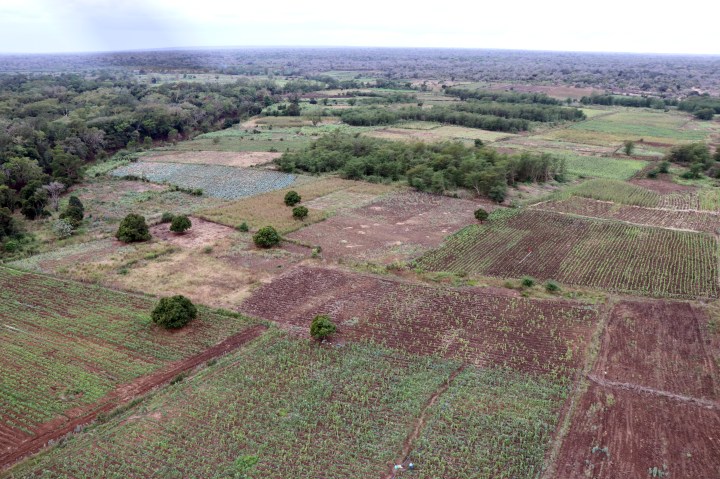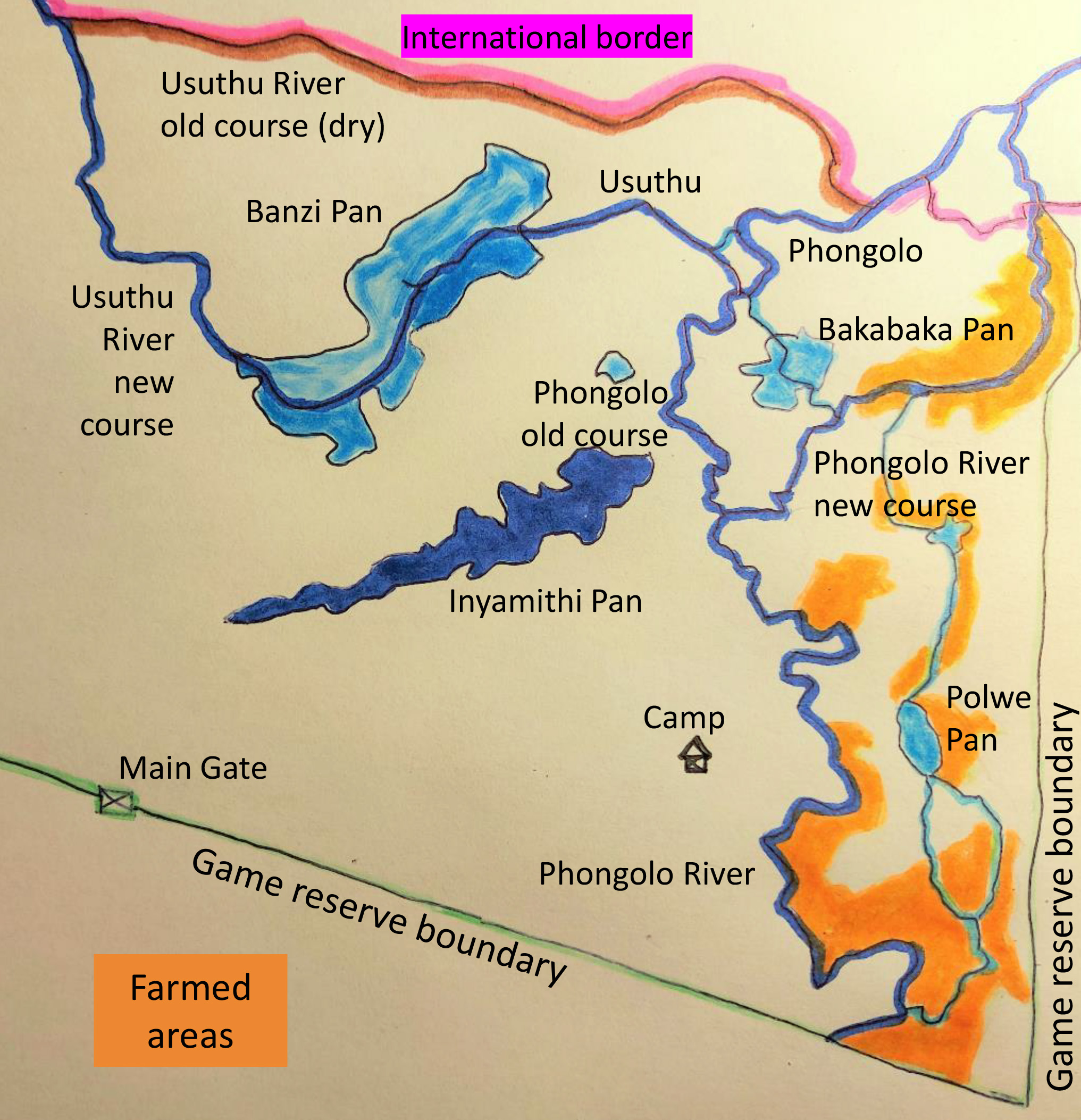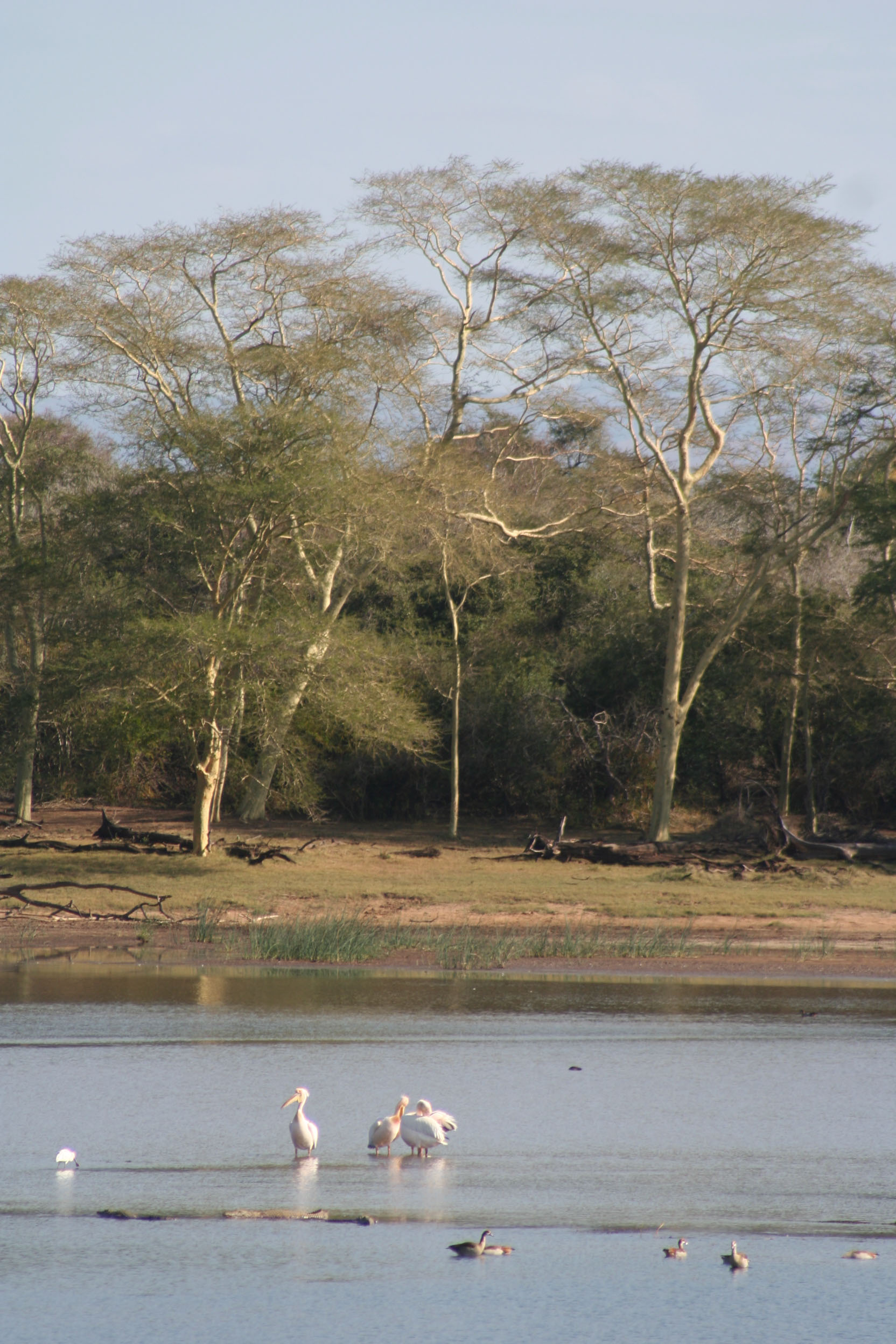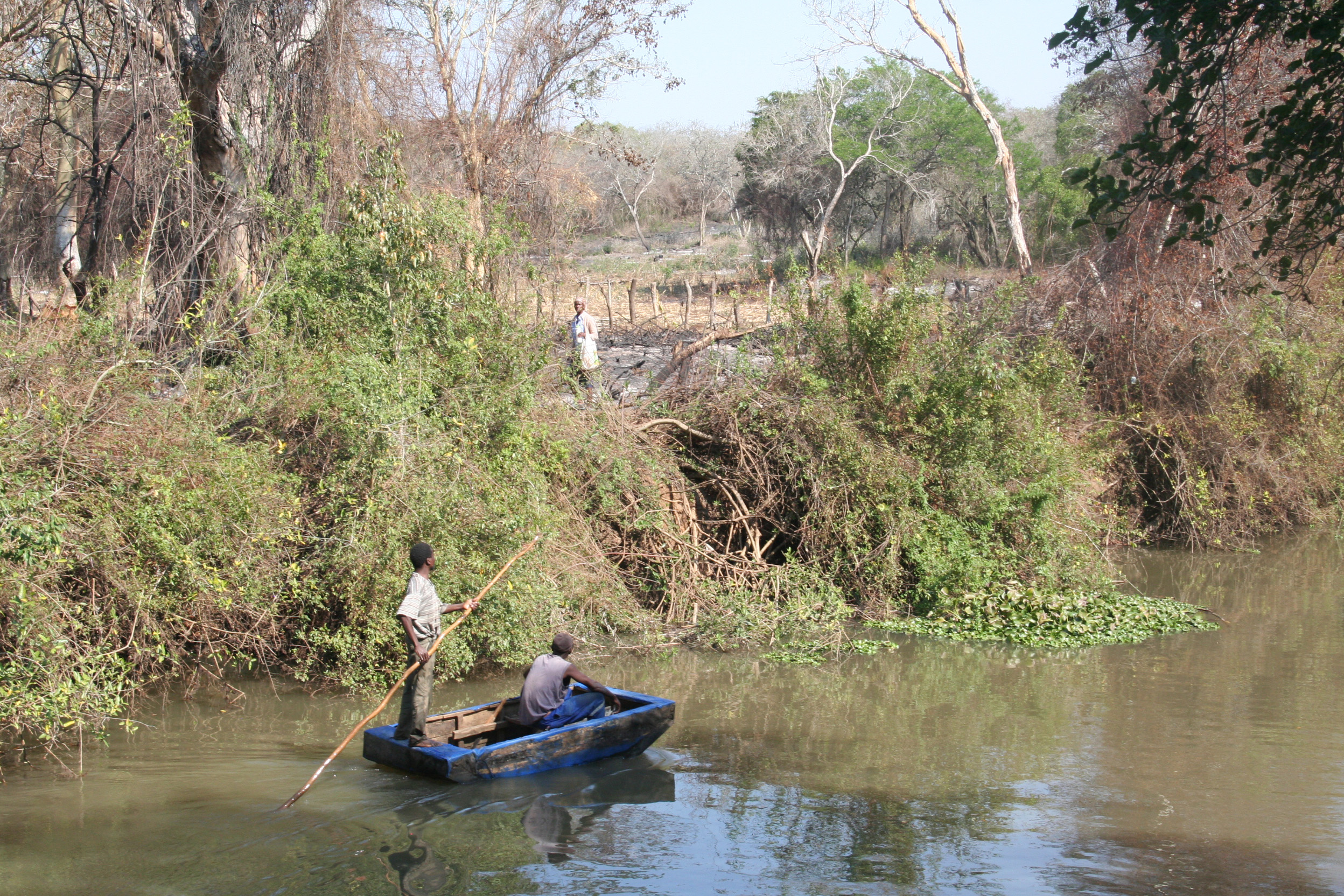WILDLIFE AND WELLBEING
Ndumo Game Reserve: The complicated balancing act of subsistence farming and nature conservation in KwaZulu-Natal

As cultivated fields expand and grazing cattle explore ever further in the Ndumo Game Reserve in KwaZulu-Natal, researchers worry about unresolved efforts to address human poverty while also trying to protect the ever-shrinking spaces left for wildlife and nature conservation.
The first piecemeal land incursions into Ndumo Game Reserve in the far northeast district of KwaZulu-Natal started just before the 2009 election season, when neighbouring subsistence farmers were promised that they could plant vegetables in a small, 20ha patch of wet and fertile soil inside the reserve.
The 10,000ha wildlife reserve was established in 1924, mainly to provide sanctuary for the rapidly vanishing hippos of the Maputaland region, on the border between KwaZulu-Natal and Mozambique.
Ndumo’s protected status was consolidated further in 1997 when the reserve was listed as a Ramsar Wetland of International Importance.
Now – more than a decade after a neighbouring community chopped down the reserve’s 11km-long eastern boundary fence – that little 20ha “cabbage patch” promise to the community has ballooned considerably.
The precise extent of cultivation and land clearance is not clear, though some sources suggest that more than 600ha of Ndumo had been cultivated or transformed by human activity by 2017, an area at least 30 times larger than the original farming area promised to communities. This area is likely to have expanded further since then.

Local women head for home after a day working in the fields inside Ndumo Game Reserve. (Photo: Tony Carnie)
Ndumo once contained the third-largest hippo population in SA, but studies show that their numbers have dropped by nearly 70% over the past 40 years. Ndumo also had a dense population of rhinos. None remain. The last survivors – a solitary black rhino bull and five white rhino – were removed in 2017 because of the high poaching risk.
The small protected floodplain area inside Ndumo’s border also provides a vital sanctuary for river fish to restock areas outside the reserve for human consumption. Studies show that fish form one of the most important sources of protein for residents of the larger Phongolo River floodplain.
Balanced against these concerns, however, is the fact that local communities who once lived, farmed, hunted or gathered natural resources in this area were driven away or expelled from the reserve by force by conservation authorities, mainly during the 1950s. Since then, the surrounding human population has grown considerably in a region with limited opportunities for economic development.
In the early 2000s, land ownership was restored to the Mathenjwa and Mbangweni communities, two separate land claimants who had lost their homes or the use of natural resources inside Ndumo. This was done with the condition that the land would remain a protected game reserve in perpetuity.
Ezemvelo KZN Wildlife, the reserve’s provincial custodian, says it “continues to work with other government departments and non-government organisations” to seek a lasting resolution to the expanding land incursions.
Nevertheless, conservation researchers fear that unless these efforts bear fruit swiftly, the illegal farming and wildlife consumption will become a permanent feature in Ndumo and establish a precedent that could spread to other protected natural areas.

The reserve once contained the third-largest hippo population in South Africa, but recent studies show that numbers have dropped dramatically. (Photo: Tony Carnie)
This has included the extensive clearance of riverine forest for crop cultivation, gill-netting of abundant fish stocks and the poaching of antelope and other wildlife.
At times, several hundred cattle also graze in the eastern part of the reserve, raising further fears about the transmission of foot-and-mouth disease.
Writing in the latest issue of the international conservation journal Oryx, researcher Dr Simon Pooley suggests that Ndumo is “facing an existential threat and may not make its 100th anniversary in 2024”.
Mozambican nationals are also entering the reserve to farm, hunt and fish via an unfenced river bed in the northern section of the reserve.
Pooley, a herpetology lecturer at Birkbeck, University of London, and researcher at the University of KwaZulu-Natal (UKZN), notes that Ndumo protects just 10% of the much larger 13,000ha Phongolo River floodplain – one of the main reasons why this reserve is a Ramsar Wetland of International Importance.
“This floodplain has the richest fish fauna of any river system in South Africa. Fishes breed there and migrate into the surrounding pans, where an estimated 500,000kg are harvested annually, sustaining cultural traditions such as fonya basket-fishing.”

A map of the eastern section of Ndumo Game Reserve showing the approximate extent of the current farmed areas (orange) within the reserve, based on an analysis of recent Google Earth imagery.
With more than 400 species of birds, Ndumo is also listed as an Important Bird Area and one of only three sanctuaries for wild Nile crocodiles in South Africa.
“The main crocodile nesting area is now disrupted by farming and gill-netting,” Pooley warns.
Commenting on disputed land-claim settlements going back almost two decades, he says: “There are allegedly two agreements: one confers co-management with benefits but no occupation, the other [which cannot be located] allegedly grants [the] right to occupy reserve land.
“Apparently, compensation remains unpaid. Exacerbated by poor relations between conservation authorities and communities – causes of which include historical evictions and violent encounters in poaching incidents – agreement on co-management has proved elusive.”

Pelicans and water birds feed in a pan beneath Ndumo’s iconic fever tree forests. (Photo: Tony Carnie)
Several efforts had also been made to resolve disputes and to support local livelihoods outside the reserve.
“However, failure of one funded plan, continuing lack of resources, local disagreements and political interference with re-establishing the fence mean conflict persists. There is a danger this long-running occupation will become accepted as the status quo.
“In the face of political instability, apparent immunity for expanding illegal land conversion, local poverty and an untenable conservation management situation, the reserve’s future is threatened, with potentially negative consequences for other protected areas in KwaZulu-Natal.”
In an article in the journal Global Ecology and Conservation, UKZN researcher Camille Fritsch and colleagues note that the area most affected by human incursion is also the best and most widely used hippo habitat in Ndumo.
The researchers collated hippo census data from 1951 to 2021 and revealed a significant decrease over recent decades. The current population of hippos had almost halved compared to previous census data from 2008.
They suggest that recent human impacts inside and along the periphery of Ndumo, combined with climate change-induced environmental changes, the unravelling and reduced capacity of the management entity, particularly in the wake of Covid-19, have put increased pressure on the protected area. This was jeopardising its value ecologically, and bringing into question its long-term persistence as a protected area and hippo sanctuary.

Large stretches of riverine forest have been cleared by the farmers. This tree was chopped up with a chain saw. (Photo: Tony Carnie)
The researchers cite a separate study suggesting that the human population living along the Phongolo River (which stretches up to Jozini Dam and beyond) had grown from 30,000 to more than 400,000 from 1980 to 2020.
Another research paper suggests that in communities surrounding Ndumo Game Reserve, more than 70% of the population survives on less than R800 a month, provided by government grants and a small informal economy, and that up to 70% of residents are under the age of 18.
Fritsch and his colleagues say the Ndumo impasse is a prime example of the need to incorporate local social issues into conservation management plans.
“Because of an exploitative political history and present continued political instability, impoverished communities surrounding Ndumo Game Reserve are socioeconomically reliant on the resources provided by the natural systems surrounding them… We recommend that the conservation management authority, sections of the South African government like the Department of Land Affairs, and local communities work together to reinstate the boundary of Ndumo to protect hippos and other wildlife in this globally important protected area.”
When DM168 asked the provincial wildlife conservation agency to comment on what it was doing to resolve the situation, spokesperson Musa Mntambo said: “Ezemvelo has been attempting to address the agricultural activities on the eastern boundary of the Ndumo Game Reserve, which is mainly restricted to land east of the Phongolo River.
“This land is part of a land-claim settlement that was settled in February 2000, and several social programmes have been implemented since then to address the agriculture activity within the reserve on community claimed land.

Local farmers pole their home-made boats along the Phongolo River to reach crop fields inside the game reserve. (Photo: Tony Carnie)
“Ezemvelo is very aware of the biodiversity importance of the Ndumo Game Reserve, and the listing as a Ramsar site because of [its] international importance. The expansion of these agricultural activities on the eastern bank has continued to expand and we are also very concerned about the impact these have on the Phongolo floodplain. This expansion has happened despite the number of community programmes that have been implemented.
“Whilst there has not been any reversal of the area being transformed, we believe that some of our interventions have limited what could have resulted in a total invasion.
“Ezemvelo continues to work with other government departments and non-government organisations to seek alternate solutions. The agricultural practices are mainly on the eastern bank. There have been some limited activities on the west bank that have been sporadic and we have successfully been able to prevent or reduce them.
“All protected areas with land occupation and/or agriculture encroachment have been listed in a national programme which looks at the risk and possible impacts on biodiversity.
“These complex issues of encroachment require a multiagency intervention and, as such, Ezemvelo has requested that Ndumo Game Reserve be identified as the KwaZulu-Natal priority for a national support and intervention programme.”
DM168 also contacted the Secretariat of the Ramsar Convention in Switzerland for its views. The convention’s mission is to work towards “the conservation and wise use of all wetlands through local and national actions and international cooperation, as a contribution towards achieving sustainable development throughout the world”.
A spokesperson responded that “we are currently undertaking investigations before any comments can be made”.
The convention, however, provides that, where a Ramsar site’s ecological character is threatened, the member nation can request a Ramsar Advisory Mission (RAM).
This mechanism enables both developed and developing countries to apply global expertise and advice to the problems and threats that could lead to a loss in ecological character to a wetland. After a site visit, the team’s draft report is submitted for review by the contracting party, and the revised final report is then published.
“The findings and recommendations in the report can provide the basis for action at the site, and possibly for subsequent financial assistance,” Ramsar says.
The national Department of Forestry, Fisheries and Environment had not responded to a request for comment at the time of going to press.
Writing in the Canadian Journal of Development Studies in 2013, social and gender researcher Talia Meer and environmental geographer Matthew Schnurr argue that tensions at Ndumo Game Reserve result from several interrelated factors, including the local community’s “historical and current feelings of loss of land, autonomy and ‘home’ as a result of colonial and neoliberal conservation initiatives”.
They argue that there has been a lack of transformation governing community-based natural resource management, compounded by frustrations related to the establishment of transfrontier conservation areas.
“We argue that the destruction and violence at Ndumo are best understood as an example of communities trying desperately to engage with state- and private sector-led conservation in the face of continued exclusion.” DM168
This story first appeared in our weekly Daily Maverick 168 newspaper which is available for R25 at Pick n Pay, Exclusive Books and airport bookstores. For your nearest stockist, please click here.






















 Become an Insider
Become an Insider
Good Morning Tony. I first visited Ndumu in 1967 and in those days a single straight dirt track headed north through the almost empty(of humans) Makathini Flats. So now there are three issues here. One-despite the absolute necessity of addressing the wrongs of the past, most of the current occupants have no historical claim to land in this area. The same thing caused the loss of half of the Dukuduku when the area was invaded by large numbers including many Mozambiquans. Second-SA is a reliable member of the world community and has a duty to protect this Ramsar site and uphold the rule of law-or not!! Finally, in the face of unchecked population growth, we ware fighting a losing battle. Unless this is addressed, mankind and his home is doomed to extinction-simple fact
Regards
Geoff Caruth
Thomas Malthus was correct , just roo early
A generally acceptable solution to the problem of overpopulation will only be found when everyone realises that overpopulation is a problem.
If you care about nature, you should use every opportunity to talk about the existential threat to humankind of too many humans.
The website “Population Matters” is very useful.
I’m so relieved to see coverage of this. May a solution of some kind be found… those forests can’t be replaced.
This is a very poor state of affairs, but unfortunately emulates the experiences in other parts of Africa. Uncontrolled human population growth and migration. Authorities are either unwilling or unable to govern effectively, and we spiral downward at an ever increasing speed. Nearly all our planet’s problems are a direct result of there being too many people to satisfy.
And the Government does absolutely nothing to protect our dwindling pristine natural areas. Too busy stealing and protecting its own criminals to do that.
Thank you Tony for writing this extremely important piece. Ndumo is a place I have visited practically every summer for the last 25 years, so it is very dear to me.
This whole disaster is yet another example of the total incompetence of Ezemvelo Wildlife to do their job. I honestly believe KZN parks would be better off being taken over by SanParks.
Do not underestimate the role of a Mozambican criminal element in these problems … I had a long chat with one of the rangers who told me the harrowing story of how he was shot in the leg by an AK47 in one of their skirmishes with these Mozambicans.